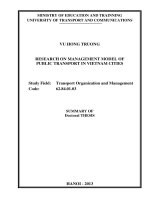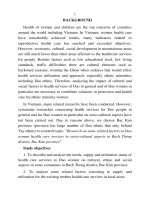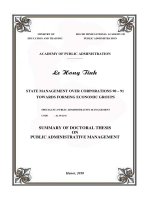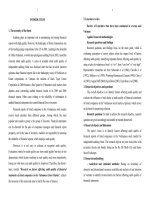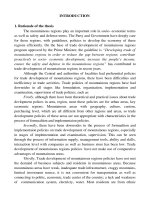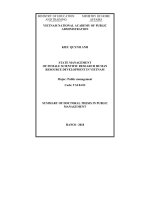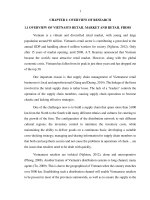Summary of Doctoral thesis: Research using on management accounting practices in manufacturing Enterprises in Vietnam
Bạn đang xem bản rút gọn của tài liệu. Xem và tải ngay bản đầy đủ của tài liệu tại đây (131.91 KB, 12 trang )
1
2
ABSTRACT
Vietnam is integrating in the trend of globalization, creating a
new era for enterprises to participate in a huge integration but there
are many difficulties and challenges in competition not only takes
place in Vietnam but also occurs among countries in the region and
in the world. In this context, the economic relations which appear in
the business performing process of enterprises become more and
more diverse and complex. In order to solve the economic relations
effectively, each company is necessarily equipped with modern
management knowledge along with the effective support of many
management tools to make the right decision in short -term as well as
long-term to achieve success in the competitive conditions at the
global level. One of the most effective management tools today is the
management accounting system.
Management accounting system supplies useful information, so
that choosing to use management accounting practices (MAPs) to
appropriate to the characteristics of each manufacturing enterprise, to
ensure economic efficiency is highly essential issue, assisting
administrators in performing their tasks to help businesses achieve
strategic objectives. MAPs in each country, each enterprise is very
diverse, affected by many factors such as from the level of economic
development, production technology, the role of professional
organizations to cultural Businesses factors ... allow businesses to
reach their main goals in order to improve business performance.
The international management accounting in general and MAPs in
particular have been studied for a long time. However, in Vietnam,
research on MAPs in manufacturing enterprises is currently a
controversial issue.
The research topic shows clearly the use of MAPs in
manufacturing enterprises in Vietnam and is influenced by internal
and external factors, determining the relationship of using MAPs
with operational efficiency in the enterprises. Since then, it is
recommended for modern equipment manufacturing investment
enterprises, improving revenue and total assets to be able to apply
modern MAPs to improve operational efficiency in enterprises.
INTRODUCTION
1. Importance of the study
Vietnamese enterprises in general and manufacturing enterprises
in particular have contributed to the development and growth of
GDP of the country in the recent years. Especially, the
manufacturing industry has experienced strong growth with the
highest growth rate in the last few years which creates the motivation
for industrialization and modernization. It contributes a great role to
the growth and increase in GDP. According to the General Statistics
Office (Ministry of Planning and Investment) in 2017, Vietnam’s
GDP growth reached 6.81%, in which manufacturing and
construction sectors (contributing 33.34%) were important elements
contribute to the improvement in growth rate.
The index of industrial production has increased by 7.85%, of
which the important contribution of manufacturing and processing
industry has achieved growth rate of 14.5% (compared to 11.9% in
2016). Based on the master plan of Vietnam's industrial development
to 2020, vision to 2030, Vietnam's industry continues to be an
important field. However, due to the influence of the world economy
has not really recovered strongly after the crisis, manufacturing
enterprises are facing many difficulties and challenges on the way of
development such as competitiveness, improper use of resources,
limited supply of raw materials. In order to achieve efficiency in
business operations - an important indicator reflecting the quality of
business operations, reflecting the ability to use resources, managers
need to make optimal decisions, limited possible risks. Among the
information system servin for optimal business decisions, it is
necessary to mention information provided by the managerial
3
4
accounting, which plays an important role in helping enterprises to
enhance the sustainable development of production and business,
reducing costs, lowering prices and improving product quality to
contribute to an instable environment.
Recognizing the importance of MAPs in manufacturing enterprises
in Vietnam, the author has selected the research topic: " Research
(4) What are the recommended solutions to encourage the
appropriate use of MAPs in manufacturing enterprises in Vietnam?
3. Subjects and scope of research
- Research subjects: the thesis focuses on the MAPs system, factors
affecting the use of MAPs in manufacturing enterprises in Vietnam
and the impact of using MAPs on effective performance in
manufacturing enterprises in Vietnam.
- Research scope:
The content: The author systematized the content of MAPs
which was classified by functional groups, focused on analyzing
factors as well as competition level, production technology,
corporate culture and structure enterprise affecting the use MAPs in
manufacturing enterprises in Vietnam, assess the impact of MAPs
use on the effective performance.
The space: Medium and large sized manufacturing enterprises in
Vietnam in processing and manufacturing industries focus mainly on
three provinces in Hanoi, Quang Nam, Ho Chi Minh City (in
addition to 13 provinces nearby Hanoi and Ho Chi Minh City), 100%
Vietnamese capital.
The time: The study used the data in the period from 2015 to
2017.
4. Methodology of the thesis
To answer the research questions, the thesis was carried out in a
throughout process and applied the combination of two qualitative
and quantitative research methods.
5. Contributions of the thesis
The thesis uses a combination of qualitative and quantitative
research methods to answer the research questions, research has both
theoretical and practical significance.
The new contributions on learning, reasoning:
- Firstly, the thesis has studied the management accounting
practices (MAPs) content based on the bisis of chassification by
using
on
management
accounting
practices
manufacturing Enterprises in Vietnam" to make a thesis.
in
2. Research objectives
The study was conducted with the general objective of studying
the use of MAPs in manufacturing enterprises in Vietnamese. To
accomplish this goal, the author identified specific objectives as
follows:
(1) Assess the current status of MAPs use in managing and
providing management accounting information in manufacturing
enterprises in Vietnam.
(2) Develop a research model of factors affecting the use of
MAPs and test the impact of each factor on using MAPs in
manufacturing enterprises in Vietnam.
3) Determine the affect the use of MAPs on the effecttive
performance of manufacturing enterprises in Vietnam.
(4) Determine some solutions to use MAPs appropriately in
manufacturing enterprises in Vietnam.
To achieve the research objectives, the author built the following
questions:
(1) How is the MAPs used in manufacturing enterprises in
Vietnam?
(2) What are the factors which affect to the use of MAPs in
manufacturing enterprises in Vietnam? What is the direction and
degree of the effect of each factor?
(3) Does the use of MAPs have an impact on the effective
performance in manufacturing enterprises in Vietnam?
5
6
functional groups and indicated the application of MAPs in
manufacturing enterprises including groups: Costing practice,
Budgeting practice, decision support practice, performance
evaluation practice and strategic analysis practice.
- Secondly, the thesis has studied the theoretical basis and
established a research model of the factors affecting the use of MAPs
in manufacturing enterprises such as competitiveness level,
production technology, corporate culture, structure enterprise based
on contingency theory, sociological theory.
- Thirdly, the thesis detemined the positive and significant
relationship between the use of MAPs and the effective performance
in manufacturing enterprises.
New contributions in terms of practice:
- Firstly, the thesis provided information on the reality of using
MAPs in manufacturing enterprises in Vietnam, as well the thesis
used the method of analyzing linear structural equation modeling SEM in studying the relationship between the use of MAPs and the
effective performance in the enterprises.
- Secondly, the thesis analyzed and assessed the level of positive
influence of factors such as: competitiveness level, production
technology, corporate culture, structure enterprise on the use of
MAPs in manufacturing enterprises in Vietnam to improve the
efficiency of production and business activities of Vietnamese
manufacturing enterprises.
- Thirdly, the thesis proposes recommendation for state
management agencies in creating legal corridors and operational
mechanisms for enterprise in the management accounting fields,
creating a motivation for reforminh corporate management.
Recommendation for manufacturing enterprises how to invest in
modern equipment, improving revenue, total assets, raising
awareness for business managers about the diversity as well as the
usefulness of MAPs.
The thesis structure
The thesis is based on research objectives to answer research
questions, is structured into 5 chapters as follows:
Chapter 1: Overview of the research related to the thesis
Chapter 2:Theoretical basis of the management accounting practices
system in manufacturing enterprises
Chapter 3: Research design and research methods
Chapter 4: Research results
Chapter 5: Discussion of the research results and recommending
solutions to apply appropriately management accounting practices in
manufacturing enterprises in Vietnam.
7
8
CHAPTER 1: OVERVIEW OF THE RESEARCH
RELATED TO THE THESIS
1.1. Overview of foreign researches
Up to now, there have been many foreign researches related to
management accounting in general, MAPs in particular both in terms
of theory and practice as well. Each study is in a different
perspective to achieve the purpose of the study, below is an overview
of some typical researches related to the research thesis:
1.1.1. The researches work on the use of management accounting
practices
1.1.2. The studies of factors which influence the use of management
accounting practices.
CHAPTER 2: THEORETICAL BASIS OF THE
MANAGEMENT ACCOUNTING PRACTICES SYSTEM IN
MANUFACTURING ENTERPRISES
2.1. Management accounting and management accounting
practises system
2.1.1. General overview of management accounting
2.1.1.1. Development process of management accounting
Management Accounting has been established and developed for
a long time, according to the International Federation of Accountants
(IFAC, 1998), management accounting in general and MAPs in
particular has been developed in four stages.
2.1.1.2. The management accounting concept.
In general, all the concepts which were given over time have
changed from a narrow perspective of traditional management into
high-level management activities including creating value. Due to
that change the author considered that management accounting is the
process of defining, measuring, analyzing, interpreting and
communicating information to provide financial information and
information related to external factors as well as information nonfinancial and information created internally and promptly for
managers, in order to make short-term and long-term decisions,
allowing businesses to pursue the goal of creating added value.
2.1.2. Management accounting practices system
On the Chenhall and Langfield-Smith’s studies (1998); AbdelKader and Luther’s (2006); Ahmad’s (2012), the author summarized
the MAPs by the five groups of practices: Costing system; Budgeting
system; Decision Support system; performance valuation system and
strategic analysis. Specifically:
2.1.2.1. Costing practices group
Cost classification is a tool to arrange different types of costs in
the cost system into each group according to certain characteristics;
to determine the costs of appropriate products, services or activities.
1.1.3. The researches studied the relationship between the use of
management accounting practices and business performance
1.2. Overview of domestic researches
In Vietnam, management accounting has been really interested
and used in recent years, so there are very few research materials
which fully studied on the MAPs, this is a very new field for not
only researchers but also Vietnamese enterprises as well, especially
manufacturing enterprises in Vietnam, below are an overview of
some typical researches related to research topics:
1.2.1. The researches work on the use of management accounting
practices
1.2.2. The studies of factors which influence the use of management
accounting practices.
1.2.3. The researches studied the relationship between the use of
management accounting practices and business performance
1.3. Conclusion drawn from an overview of researches related to
the thesis
9
10
Include the following practices: job costing; process costing;
Absorption costing; Variable costing; Activity based costing.
2.1.2.2. Budgeting practices group
According to Emmanuel, et al.,(1990), estimation is the most
obvious use in providing information for controlling management;
By setting performance standards and providing internal feedback on
adjustment reports, accountants provide much of the basic
information needed to master planning and overall control.
Budgeting system includes: Sale budgeting; Profit budgeting;
Budgeting for controlling cost; Production budgeting; Cash
budgeting; Budgeting for planning financial position; Annual
budgeting; Flexible budgeting.
2.1.2.3. Decision Support practices group
Support decision practices is a tool that provides information to
support business or organizational decision-making activities;
Serving an organization's management, operation and planning and
helping managers make decisions about issues that can change
quickly and are not easily determined. The system of decision
support pracetices system emphasizes flexibility and adaptability to
match changes in the environment and user decision-making
approach. Including: CVP analysis; Product profit analysis; NPV;
IRR; TQM.
2.1.2.4. Performance valuation practices group
In the study of the author Emmanuel et al., (1990), performance
valuation is a very important function in management accounting.
Performance valuation provides information to managers to support
the organization's strategic goals (Jusoh and Parnell, 2008). The
selection of measures to guide and evaluate the businesses
performance is one of the most important challenges faced by
organizations. In general, both financial and non-financial measures
are used to measure the effectiveness. Including: Economic value
added; ROI; Variance Analysis; Standard costs & variance anlysis;
Return on investment; cash flow; Survey of customer satisfaction;
Employee attitude.
2.1.2.5. Strategic analysis practices group
The last group of MAPs is strategic analysis. Strategic analysis
method is to use tools to provide, analyze financial information about
the market of manufacturing enterprises and the cost of competitors,
to use in development and monitoring strategic business of
enterprises, especially the relative level of price, actual cost, volume,
market share, cash flow and the required rate of the overall resources
in the enterprise. This method provides the financial information
needed to monitor the current strategy or assist in developing
strategies or in other words to support the successful construction of
a competitive advantage for businesses. Including the following
methods: Target costing; Product life cycle analysis; Value chain
analysis; Balanced score card; Just in time system.
2.2. Factors affecting the use of accounting management
practices
2.2.1. External factors
The competition level
The competition level in the market is defined as an organization
competing with other organizations for products, services and prices
in the external environment (Cadez and Guilding, 2008).
Organizations often compete for resources such as competition for
materials, sales and distribution channels, product quality and
diversity, product prices (Gordon and Narayanan, 1984).
2.2.2. Businesses’ factors
2.2.2.1. Production technology
According to Kennedy (2006), defined the manufacturing
technology is a group of integrated hardware and software
technologies, which are implemented, monitored and evaluated,
which will help improve efficiency and productivity or supply a
product, or provide service.
11
12
According to the author, production technology is defined in a
wide range of automated production systems of people, machines
and tools are used to plan and control the production process
including the purchase of raw materials and components and delivery
/ service / finished products. Including computer-aided design (CAD)
and technical systems, material resource planning systems,
automated material handling systems, robots, flexible computer
control systems, JIT, electronic data exchange and computer
integrated production system.
2.2.2.2. Corporate culture
Corporate culture is an important concept in management.
Culture is defined as a characteristic set of souls and knowledge,
which is the difference of membership of one group with another
(Hofstede, 1980; Choe, 2004). Corporate culture is used to refer to
"the values, beliefs, action methods ... widely shared" by the
members of the organization and allow the creation of specific
features of this organization, compared to other organizations.
2.2.2.3. Enterprise structure
Enterprise structure is defined in different ways in studies.
According to Macy and Arunachalam (1995, p. 69): “The structure
of the enterprise represents models and relationships that exist
between the units of work and organization”; "Enterprise structure is
a product that not only imposes a need for integration by complex
technology but also applies the rationalization of applying
appropriate structural models."
2.3. Efficiency of business performance and the impact of using
accounting management practices on performance
2.3.1. Business’ Effective Performance
Effective Performance of the organization is an important
economic category in business activities of enterprises, understood in
many different angles.
Based on the author's point of view, efficiency of performance is
an economic category reflects the level of choice of using resources
in the enterprise to achieve the target. To measure the enterprises
performance, it should be measured both financially and nonfinancially. Referred to the assessment of financial performance, it is
measured according to the following criteria: ROI, Gross profit,
Revenue growth, Consumption revenue, Profit rate on revenue,
Profit rate on total assets, Profit rate return on equity ... Based on the
evaluation of non-financial performance, it is measured according to
criteria such as: Quality of goods / services, Labor productivity,
Customer satisfaction, Market share, develop new products /
services, compare with competitors ...
2.3.2. Impact on the use of management accounting practices to
effective performance
According to the author, the evaluation of effective performance
in enterprises is considered one of the most important and difficult
tasks for most enterprises. Therefore, using MAPs as a tool to
provide accurate, timely information about the results of business
operations, inspection, evaluation and service of management
decisions of internal managers treatment in enterprises.
Administrators will be provided with complete information about the
costs incurred and if exceeded, the administrator will find the cause
and the necessary solutions. Administrators who are personally
responsible for the operation of departments and organizations to
achieve the organization's goal in order to reduce costs, increase
revenue, increase capital efficiency and will improve the enterprises
performance.
2.4. Some fundamental theories are related to thesis
2.4.1. Contingency theory
2.4.1.1. Content theory
2.4.1.2. Apply Contingency theory to research issues
2.4.2. Sociological theory
2.4.2.1. Content theory
2.4.2.2. Applying sociological theory to research issues
13
14
CHAPTER 3: RESEARCH DESIGN AND RESEARCH
METHODS
3.1. Research design
3.2. Research model
3.3. Qualitative research methods
In order to conduct qualitative research, the author conducted indepth interviews (Face to Face) on a narrow scale with experts (chief
accountant, general accountant, director of the enterprise; Art) are
those who have experience in choosing to use MAPs in some
manufacturing enterprises.
To find more about the factors affecting MAPs use in
Vietnamese manufacturing enterprises in Vietnamese, the author
stratified is random sampling to ensure that all classes have an
appropriate representation (Ghauri et al., 1995) through the
stratification process. This method allows results from small groups
to be compared to ensure whether or not sample size differences
affect the use of MAPs.
3.4.1.3. Sample scale
According to Hair et al., (1990), to conduct multivariate
regression, the sample size must ensure the formula n≥8m + 50
(where n is the sample size, m is the number of independent
variables in the research model). In this study, there are 10
independent variables, so the minimum sample size used for analysis
is 130. To ensure sufficient observations are used in regression
used the question: "According to your perspective, which factors are
affected to the use MAPs in your enterprise? Why?".
To study more about the impact of using MAPs on the
performance of manufacturing enterprises in Vietnam, the author
uses the question: " According to your perspective, do you think
there is any impact on the performance of your business when using
MAPs in enterprises? How does it affect? Why".
3.4. Quantitative research methods
3.4.1. Data selection
3.4.1.1. Overall goal
The overall goal identify information gathering to answer these
research questions in the secondary industry of the processing and
manufacturing industries.
3.4.1.2. Sampling method
To control the relative size of each sample, stratified sampling
procedures will be used, since each sample of the different
production sectors is considered to be heterogeneous. The idea of
analysis and represent the whole, according to calculations from the
yearbook The 2017 statistic will conduct the survey on a scale of 750
enterprises (50% overall) in detail according to the industry code
(Table 3.3).
3.4.2. Data collection
This study conducted surveys to collect data from sending
questionnaires (directly; via post; combining sending e-mails to
enterprises with e-mail addresses). Questionnaires were built directly
at the company (based on familiar relationships) or by post and
combined questionnaires via Google form tool (for enterprises
sending email by link:
/>is a popular tool used in experimental accounting research.
3.4.3. Building scale
3.4.3.1. Management Accounting practices
3.4.3.2. Factors affecting the use of MAPs
15
16
3.4.3.3. Effective performance of enterprises
3.4.4. Data analysis methods
The structural model (SEM) is used as the main statistical
technique for testing hypothetical models developed in this study
(H1-H5). In addition, multi-group structure analysis techniques are
used to test H6-H8 hypothesis.
3.4.4.1. SEM structure model
The SEM approach is chosen to answer question 2.3 (There are
factors that affect the use of MAPs and the impact of using MAPs on
business performance) and to test hypotheses from H1-H8. SEM is
"a set of statistical techniques that allow the establishment of
relationships between one or more independent, continuous or
CHAPTER 4: RESEARCH RESULTS
4.1 Results of experimental research
4.1.1. Sample procedures and data collection
4.1.2. Data analysis
4.1.3. Discuss experimental research results
4.1.3.1. Management Accounting practices
4.1.3.2. The competition level
4.1.3.3. Production technology
4.1.3.4. Corporate culture
4.1.3.5. Business structure
4.1.3.6. Effective Performance
4.1.4. Conclusion and meaning for formal research
discrete variables and one or more dependent or continuous or
discrete variables examined" ( According to Tabachnick and Fidell,
2007 cited in Doan, 2012, p.89).
3.4.4.2. Data distribution and estimation techniques
Before developing the SEM model, a number of tests need to be
carried out with SEM assumptions.
-Test of reliability (Test for Reliability) of scale with
Cronbach’Alpha coefficient:
- Exploratory factor analysis - EFA:
- Confirmatory factor analysis - CFA:
3.4.4.3. Multi-group structure analysis
Multi-group structural analysis was selected to compare the
research model by group of qualitative variables (such as the size of
medium and large enterprises, the group of new and old operating
periods, the group of materials production sectors and consumer
goods...).
4.2. Official research results
4.2.1. Feedback results
As shown in Table 4.8 (from Appendix 3), the majority of
respondents are in textile and footwear production (32.5%); then in
areas such as cement, construction materials (15.8%); Furniture
(11.8%);
Manufacturing
food
and
beverages
(9.6%);
Pharmaceuticals and chemicals (6.6%); Manufacturing products
from rubber and plasstic (6.1%); other manufacturing sectors (5.3%);
Paper and printing production (4.8%); Electrical-electronic
equipment products (4.4%); Machinery and engines (3.1%).
4.2.2. The result of using management accounting practices in
manufacturing enterprises in Vietnam
Table 4.10 summarizes the survey results on MAPs application
rates in manufacturing enterprises in Vietnam. In this table, the
methods are listed in order of priority, from enterprises with the
highest MAPs application rates to those with the lowest application
17
18
rates. Overall, the average rate of applying MAPs in all surveyed
enterprises and for all surveyed manufacturing sectors was 68.77%.
4.2.3. Results of scale test
4.2.3.1. Results of verification of reliability of Cronbach’Alpha
scales
Through testing of scales on MAPs, the influencing factors and
operational efficiency of enterprises show that all scales are suitable
and reliable with statistical significance to use analysis in
manufacturing enterprises in Vietnam.
4.2.3.2. Scale test results by exploratory factor analysis (EFA)
The results of the load coefficients of the factors, AVE and
Crongbach’alpha. All indicators are good (> 0.5) and the values of
business scales is not different, so we use Sig value. Equal Variances
Assumed gives T-test sig value = 0.884>0.05 so there is no
statistically significant difference in the use of MAPs by different
sized enterprises.
- Operation time: According to the data presented in Appendix
5b, Sig. = 0.657> 0, 05, the variance between the two operating time
intervals is not different, so we use the value of sig.T- Test Equal
Variances Assumed for T-test sig values = 0, 573> 0.05, so there is
no statistically significant difference in MAPs use by enterprises
with new and long-term operating times.
- Operation: According to the data presented in Appendix 5c,
showing Sig. = 0.710> 0.05, the variance between the two operating
the observed variables are reliable and AVE is at the allowable
threshold (Crongbach’alpha> 0.7; AVE> 0.5).
4.2.3.3. Scale test results by confirmatory factor analysis (CFA)
a- Results of CFA test for MAPs
The obtained CFA results have Chi-square / df = 2,259 values;
GFI = 0.903; TLI = 0.952; CFI = 0,966; RMSEA = 0.075. These
values showed that the scale of the MAP intermediate variable was
basically consistent with market data.
b- Results of CFA test of scale for independent factors
The obtained CFA results have Chi-square / df = 1,549 values;
GFI = 0.906; TLI = 0.952; CFI = 0.959; RMSEA = 0.049. These
values demonstrated the scale of competitive environmental factors,
production technology, corporate culture and enterprise structure in
line with market data.
c. Impact of qualitative variables on the use of MAPs
- Scale of business: According to the data presented in Appendix
5a, it shows that Sig = 0.844> 0.05, the variance between the two
groups (production of raw materials supply and consumer goods) is
not So we use the Sig value. -test in Equal Variances Assumed for
the T-test sig value = 0.137> 0.05 so there is no statistically
significant difference in MAPs use by businesses different
production. In other words, it is not enough to confirm that there are
differences between groups for dependent variables.
d- Results of CFA test of critical measurement model
The critical model is a model in which potential variables are
freely related to each other. To test the differentiation of all potential
variables, the author will use a Saturated model as shown in Figure
4.4, showing values like Chi-square / df = 1,376; GFI = 0.902; TLI =
0,922; CFI = 0,927; RMSEA = 0.041. These values show that the
scale of critical theory is consistent with market data.
Thus, after the CFA test, the obtained results set the standard scale as
a basis to conduct testing models and research hypotheses.
4.2.3.4. Results of testing models and research hypotheses
a- Results of testing the research model
19
20
Research model is used to determine the load factors of each
potential variable. Each potential variable is not directly observed, it
is measured based on the number of scales (observed variables)
obtained from the survey or other sources. Six potential variables are
built according to the proposed model:
- The level of competition
- Production technology
- Corporate culture
- Enterprise structure
- MAPs
- Performance
The results showed that the values of Chi-square / df = 1,378;
- According to the results presented in Table 4.26, the
relationship between production technology and the use of MAPs is
positive (standard regression weight β = 0.24; p <0.05), supporting
the hypothesis H2 (Production technology positively affects MAPs
use in manufacturing enterprises in Vietnam).
- According to the results presented in Table 4.26, show that the
relationship between corporate culture and the use of MAPs is
positive (standard regression weight β = 0.17; p <0.05), false support
H3 theory (enterprises with strong corporate culture support the
ability to use MAPs to be more successful in manufacturing
enterprises in Vietnam).
- The structure of enterprises in Vietnamese manufacturing
GFI = 0,901; TLI = 0,921; CFI = 0.926; RMSEA = 0.041. This result
demonstrates that the research model is suitable for market data.
SEM linear model analysis we have test results show that the
relationships are statistically significant. In the relationships, the
impact of competition on the strongest level of MAPs utilization
(0.255); and the impact of DN structure on the weakest use of MAPs
(0.146);
4.2.3.5. Testing research hypotheses
From the SEM test results, the hypotheses from H1-H5 are
commented as follows:
- The results are presented in Figure 4.5 and Table 4.26 indicate
that the relationship between competition level and the use of MAPs
is positive (standard regression weight β = 0.26) and significance
level (p < 0.05), thus supporting hypothesis H1 (The level of
competition has a positive effect on the use of MAPs in
manufacturing enterprises in Vietnam).
enterprises has a positive relationship with the use of MAPs
(standard regression weights β = 0.15; p <0.05), accepting hypothesis
H4 (Enterprise structure) have a positive influence on the use of
MAPs of manufacturing enterprises in Vietnam).
- Hypothesis H5 proposed that the use of MAPs has a positive
and significant effect on performance. The results are presented in
Table 4.26, showing that the effect of MAPs use on performance is
positive and meaningful (standard regression weight = 0.20; p <0.05)
provides the support this hypothesis.
4.2.3.6. Analyzing the impact of regulatory variables by multi-group
structure analysis
21
22
CHAPTER 5: DISCUSSION OF RESEARCH RESULTS AND
SOLUTIONS TO USE SUITABLELY FOR ACCOUNTING
PRACTICES IN MANUFACTURING ENTERPRISES IN
VIETNAM
5.1. Discussion of research results
5.1.1. Discussion of the results on the status of using accounting
management practices in manufacturing enterprisesin Vietnamese
5.1.2. Discussion of the results of the factors affecting the use of
accounting management practices in manufacturing enterprisesin
Vietnamese
5.1.2.1. Competitiveness factor and use of MAPs
5.1.2.2. Production technology factors and the use of MAPs
5.1.2.3. Corporate culture factors and the use of MAPs
5.1.2.4. Enterprise structure elements and the use of MAPs
5.1.3. Discussion of the results of the application of management
accounting practices affect the performance of Vietnamese
manufacturing enterprises
5.2. Proposing a number of solutions to appropriately apply
accounting
management
practices
in
manufacturing
enterprisesin Vietnamese
Based on the conclusions in the study, the author boldly
proposed some solutions in the direction of the following contents:
choosing to use appropriate MAPs in enterprises; the impact of
factors on the use of MAPs as a factor of enterprise competitiveness;
advanced production technology, corporate culture, enterprise
structure for businesses and for related agencies
5.2.1. Apply appropriate management accounting practices
According to the results in Table 4.10 (Chapter 4), in which
some enterprises have effectively applied these new practices to
implement the strategic objectives of enterprises.
5.2.1.1. BSC practice
BSC model is applied in all businesses with unified goals
and focus on goals, balancing the participation of stakeholders, but
depending on the size of enterprises, there will be BSC indicators.
different. Some models of BSC models and reference situations are
based on actual surveys (Appendix 7).
5.2.1.2. TC practice
The application of the TC method is a tool to manage the
cost according to the target profit taking into account the life cycle of
the special product is the appropriate new product. The TC method is
tied to the efforts made at the design stage and the production phase
to achieve the established TC, the goal is to enable the production of
products that achieve targeted profits throughout the life cycle. of the
product (Appendix 7).
5.2.2. Solution from factors affecting the use of MAPs
Firstly: Create a competitive environment for businesses
In order for businesses to exist and develop in the current
environment, each enterprise selects for them different tools to create
competitive advantages compared to other competitors in the market.
One of those tools is the source of raw materials, input materials,
focusing on sales and distribution activities, the variety of products /
services especially the quality of products as well as product prices
...
Secondly: Investment in modern production technology
Authors proposed enterprises should establish / maintain R&D
centers, this center has the task of researching and improving
existing products; improving existing technology processes; new
product design; designing / applying new technology processes; At
the same time, to operate the production lines, enterprises need to
maintain flexible production systems, design and support computers
and integrate some modern technologies such as cooperative-system
robots Robotic system designed to work safely with humans, this
23
24
system features customization, accuracy as well as fast processing
speed.
Thirdly: Building corporate culture
The author proposed in each enterprise should have the structure
of research organization and established a new management
department in the enterprise management system to specialize in
cultural management enterprises applied in most businesses. In an
enterprise, this department's performance will effectively create a
cohesive culture between employees and departments; individuals in
the organization also shared the advantages and difficulties of
enterprises, they are proud to be part of the organization, thereby
creating the motivation to strive and contribute to the common goal
of organization and upgrading. High business performance and
differentiation in the market of management and a tool to support the
application of new management methods and modern power.
Fourthly: Flexible organizational structure
A flexible organizational structure is that when the environment
has many changes, organizations respond promptly to not be
eliminated from the economy. There is no suitable organizational
structure for all businesses, depending on the mission and strategy of
the business, but choose to build an appropriate organizational
structure. Therefore, in the current volatile environment, the author
proposed enterprises, should organize the organizational structure
according to the matrix model (Appendix 8).
5.2.3. Conditions for implementing the solution
If enterprises play an active role in improving competitiveness,
technological innovation, building corporate culture and
implementing flexible organizational structure to use appropriate
MAPs and improve operational efficiency. For enterprises, the
Government and concerned agencies play a role of "midwife" for
enterprises that can implement solutions.
Regarding the State and related agencies:
On the enterprises side:
5.3. Limitations and future work
Like other studies, this study does not avoid some limitations
that require further research. Although this study has contributed
significantly to the link between research variables, there are some
limitations to clarify.
CONCLUSION
The thesis has studied the basic theoretical framework of
management accounting, MAPs and the content of factors affecting
the use of MAPs in manufacturing enterprises in Vietnam, and the
impact of using MAPs on operational efficiency and basis for
researching and providing solutions for Vietnamese manufacturing
enterprises.
This study has been designed to achieve research objectives and
answer research questions. The thesis has inherited previous research
results in the world and Vietnam as well as used some related
theories such as uncertainty theory, sociological theory.
The thesis uses survey methods, sends questionnaires and
analyzes the content of in-depth interviews with experts at
enterprises and universities, and the thesis has evaluated the status of
using MAPs in Vietnamese manufacturing enterprises; analyzing the
causal relationship between competitive environment and advanced
manufacturing technology, corporate culture and enterprise structure
with the use of MAPs; The link between MAPs use and
performance. The findings from this study also provide a useful
guide for organizations, especially in the management of enterprise
administrators, to make decisions in the current changing
environment. In addition to these contributions, the results of this
study also provide useful guidance for the future.

